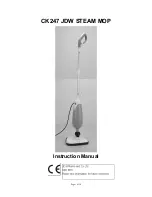
Page 8 of 10
NOTICE: If power is turned off in the middle of the warm-up, or after the warm-up is
complete, the product may repeat the above warm-up operation, depending on how
long the power has been off.
The Steam Head has a wide range of motion
– it can clean into corners, and also under low
objects.
CLEANING AND MAINTENANCE
WARNING: BE SURE THAT THE UNIT IS DISCONNECTED FROM THE ROWER
OUTLET WHEN PERFORMING CLEANING
Drain the remaining water in the tank and clean the tank after every use.
How to decalcify the Water Tank interior:
To clean calcium deposits that build up inside the Water Tank , add one or two tablespoons of
white vinegar to a full Water Tank close the Water Tank Cap and then shake the contents.
DO NOT TURN THE STEAMER ON.
Cleaning procedure to remove lime scale:
If your steam mop begins to produce steam more slowly than usual or stops producing steam,
you may need to remove lime scale. Lime scale can develop over time on the metal parts
and greatly affect mop performance.
It is necessary to remove lime scale on regular basis every 25-50 times you use a full tank of
water or at least once a month, especially in areas with hard water.
The frequency of lime scale removal depends upon the hardness of your tap water and how
often you use the steam mop.
Follow this procedure to remove lime
By the use of cleaning tool
1. Check to ensure that the power supply is disconnected
before beginning.
2. Use the cleaning tool to remove the scale, as shown.
3. Move and rotate the cleaning tool to clean the vents.
Continue until all scale is removed from the outlet holes.
By using cleaning solution
1. Prepare a solution of 1/3 white vinegar and 2/3 tap water and add to the water tank.
2. Secure and position the unit to ensure that the steam released is aimed away from the




























